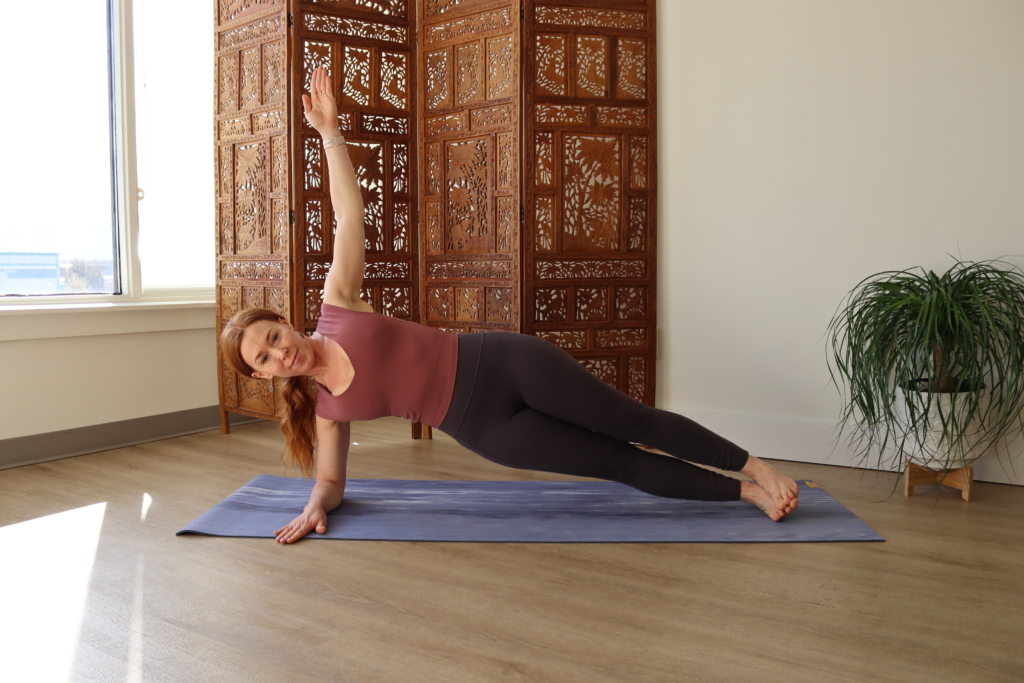This entry was posted on Jun 12, 2024 by Charlotte Bell.

Do you practice Side Plank Pose (Vasisthasana)? I’ll admit that it hasn’t always been a part of my regular practice routine. That’s because, well, it’s hard. But it’s also because, in recent years, I’ve found that the “full” version of the pose is not so great on my hands and wrists.
As an instrumentalist (oboe and English horn), I can only do so many Downward Facing Dog Pose-Upward Facing Dog Pose-Chaturangas before I feel that my hands and wrists have had enough. The same is true for Vasisthasana. In the past, I’ve avoided the pose altogether, because I need to save my hands and wrists for playing music. However, one simple variation allows me to glean the benefits of Vasisthasana without compromising my hands and wrists.
If you want to know more about the traditional version of Vasisthasana, check out this post. It also includes an interesting explanation of the mythology behind the Side Plank’s Sanskrit name.
Why Practice Side Plank?
Side Plank confers so many benefits. Its strengthening power is especially important for bendy practitioners.
- Strengthens your abdominals: Side Plank Pose strengthens your core and spine. The pose simultaneously engages the rectus abdominius, transverse abdominus and obliques.
- Strengthens low back and hip muscles: Side Plank strengthens the muscles in your lower back and hips. Hip and back pain are often caused by weak muscles in these areas. While crunches and situps are better-known ways to strengthen your abdominals, Vasisthasana, unlike crunches and situps, strengthens the abs without putting pressure on the muscles of the low back.
- Strengthens the upper body: Vasisthasana also strengthens your shoulders, wrists (in the traditional version), and arms.
- Improves balance: Side Plank is a balancing pose, so it helps you cultivate your balancing skills. In addition to the challenge of balancing on one hand (or arm) and one foot, we’re also balancing with our heads in a horizontal position. This helps stimulate the vestibular system, which is involved in balance and proprioception.
Side Plank Contraindications
Like every other yoga pose, Side Plank Pose may not be for everyone at all times. If you are experiencing any of the following conditions, you should practice with care or avoid Vasisthasana altogether:
- High blood pressure, migraines, rheumatoid arthritis or any cardiovascular conditions
- Recent abdominal surgery
- Pregnancy, especially in the first trimester
- Active injuries to the hips, back, ankles, shoulders or neck
- This contraindication is somewhat rare. Side Plank can cause rib displacement. If your body isn’t prone to displaced ribs, practicing it shouldn’t be a problem. But some extra bendy people suffer this tendency, which is quite painful. It this is you, avoid practicing Side Plank.
- If you feel pain anywhere while you’re in the pose, leave the pose.
How to Practice Vasisthasana Variation
- Lie on your right side on a Yoga Mat.
- Place your right forearm, palm side down, on your mat, perpendicular to your body. Your elbow should be right under your shoulder, and your head, shoulders and chest will be angled away from the floor. Leave the right side of your pelvis on your mat.
- Stack your left foot on top of your right foot.
- Now press down with your right arm to lift your torso and legs off the mat.
- You can either extend your left arm up toward the sky, or leave your left hand on your left hip.
- Avoid letting your pelvis sag down. Use the back and core muscles of your right side to lift the pelvis so your body is in a straight, diagonal line.
- Relax your head, looking straight ahead rather than attempting to look up toward the ceiling, which can be hard on your neck.
- Take 5 to 10 deep breaths. You can also set a timer for 20 to 30 seconds, and then build the duration of the pose over months.
- Release your body back down to the floor, continuing to support yourself with your forearm. This allows the right side of your body to receive a gentle stretch.
- Practice your other side.
About Charlotte Bell
Charlotte Bell discovered yoga in 1982 and began teaching in 1986. Charlotte is the author of Mindful Yoga, Mindful Life: A Guide for Everyday Practice and Yoga for Meditators, both published by Rodmell Press. Her third book is titled Hip-Healthy Asana: The Yoga Practitioner’s Guide to Protecting the Hips and Avoiding SI Joint Pain (Shambhala Publications). She writes a monthly column for CATALYST Magazine and serves as editor for Yoga U Online. Charlotte is a founding board member for GreenTREE Yoga, a non-profit that brings yoga to underserved populations. A lifelong musician, Charlotte plays oboe and English horn in the Salt Lake Symphony and folk sextet Red Rock Rondo, whose DVD won two Emmy awards in 2010.

